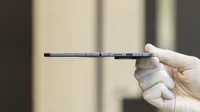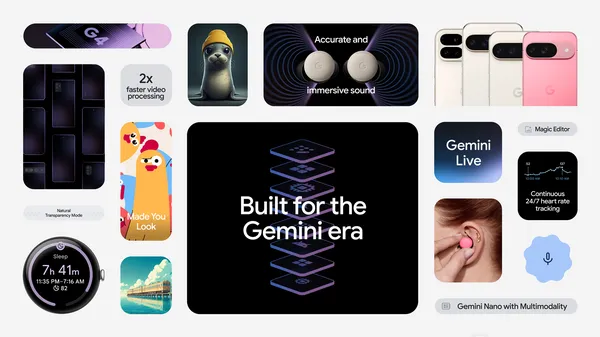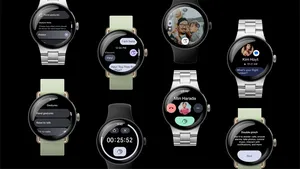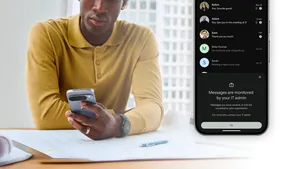How we redesigned the Pixel 9 Pro Fold and made it thinner

The new Pixel 9 Pro Fold is more than just an update of its predecessor — it’s been fully redesigned and upgraded from the first-generation Pixel Fold. One of the biggest improvements is that it’s even thinner than the first Fold: In its folded form, the Pixel 9 Pro Fold is a full 1.5 millimeters thinner than its predecessor and only 2 millimeters thicker than our Pixel 9 series phones. And at 5.1 millimeters deep when open, the new Fold shaves off 0.7 millimeters from the original open Fold as well — meaning it’s thinner than most tablets. In fact, it’s the thinnest foldable phone 1 — with the largest display for any smartphone 2 — on the market.
“We knew when we made the second one, it had to be thinner,” says Pixel product manager George Hwang. “But we didn’t know how much thinner, and we didn’t know what we’d have to do to get there.” Here’s how the Pixel team answered those questions to build a thinner Fold while upgrading the phone’s displays, cameras and more in the process.


Designing a phone and then a foldable
One insight that steered the team toward the phone’s new design was how people interacted with the original Pixel Fold, says director of industrial design Claude Zellweger: “We saw that people were often using it closed.” Even though people are interested in the new form factor and want the added bonus of the tablet-like experience, people also want to use their foldable like a regular smartphone. “That’s what led us to say, ‘Hey, we need to make this a phone first in terms of design,’” Claude explains. “Our mantra became ‘phone first.’”
The goal was to make a foldable that felt, looked and acted primarily like any smartphone — and offered additional functionality on top of that. “You have to make a great phone, and then you can make a great foldable,” says Jon Prowse, a Pixel product manager.
But what does it mean to be “phone first”? A lot of things — for example, the Pixel 9 Pro Fold’s display has an aspect ratio of 20:9, the same as the Pixel 9 Pro. And it boasts the same premium finishes as well as smaller bezels than the previous generation's. All of these things combine to more closely mimic the rest of the 9 series Pixels in a way that makes them ultimately more familiar to the eye and the hand: Things like web browsing or messaging with the device closed are more similar to the latest generation of Pixels than to the prior Fold.
And, of course, the fact that it’s thinner and thus closer to the size of the Pixel 9 is a crucial part of this experience. Especially noteworthy is that despite the new “thinness,” the team found a way to fit in the phone’s upgraded centerpiece: a massive, 8-inch tablet-like display.
Developing an all-new hinge
“To go thinner, we knew we needed a new hinge,” George says. The team came up with a design for the multi-alloy steel, high-strength aluminum alloy-covered hinge that not only snaps shut — it opens fully flat with a satisfying snap, too. The new hinge is also more durable than its predecessor, but includes some of what people loved about the original. “For example, we mimicked the hinge’s torque — the feel across the range of motion — from the Pixel Fold,” George says.
Also like last time, they studied and researched various items that felt pleasant to open and close. Claude says this provides something of a subliminal effect, but it’s a detail that people find delightful, so it was worth the team focusing on, too. The upgraded fluid-friction hinge and optimized magnets that snap the device shut deliver a just right feeling.
Creating a better camera with less space
Building a thinner phone with high-performance photography isn’t without its challenges though — camera technology can take up a lot of room. “As we were designing this and thinking about making it so much thinner, we chose to completely redesign the camera bar and include customized optical modules,” Jon explains. Ultimately, they were able to upgrade the ultrawide camera, along with two selfie cameras, to fit in those newer, more capable optical modules. The idea was to make sure they met the high bar people have to expect from Pixel’s camera quality. And they did: Pixel 9 Pro Fold’s various hardware upgrades mean it includes pro-level camera tools like Video Boost and Pro Controls; in fact, all of these upgrades make it the best camera on a foldable 3 .
The new double-stacked camera bar is positioned in the new Fold’s top left corner, allowing the phone to become thinner and lie on surfaces more evenly as well. The change also helped engineers implement a bigger battery, too.
Adding everything up for a major update
While changes to the camera bar and hinge helped the Pixel 9 Pro Fold get thinner, a bunch of other tweaks also helped to take millimeters off the phone. For example, it has a custom, thinner haptics driver. “It actually makes the haptics feel more pronounced, so it’s an even nicer feel,” George says. The USB-C port is also a custom, smaller version than the original Fold’s, and the speakers are all-new, too. Additionally, to overcome the thermal limitations of a thinner device, the team re-engineered the thermal architecture with an all-new vapor chamber and graphite thermal spreader.
George, Claude and Jon could go on about the seemingly small tweaks that helped make the phone thinner — these less-than-flashy changes proved so crucial. “With this process, it really goes to show that when you make a big architecture improvement, every piece of the phone — every single module — matters,” Jon explains. “It takes a lot of incremental change to result in this big change.” Or in this case, this thin change.






